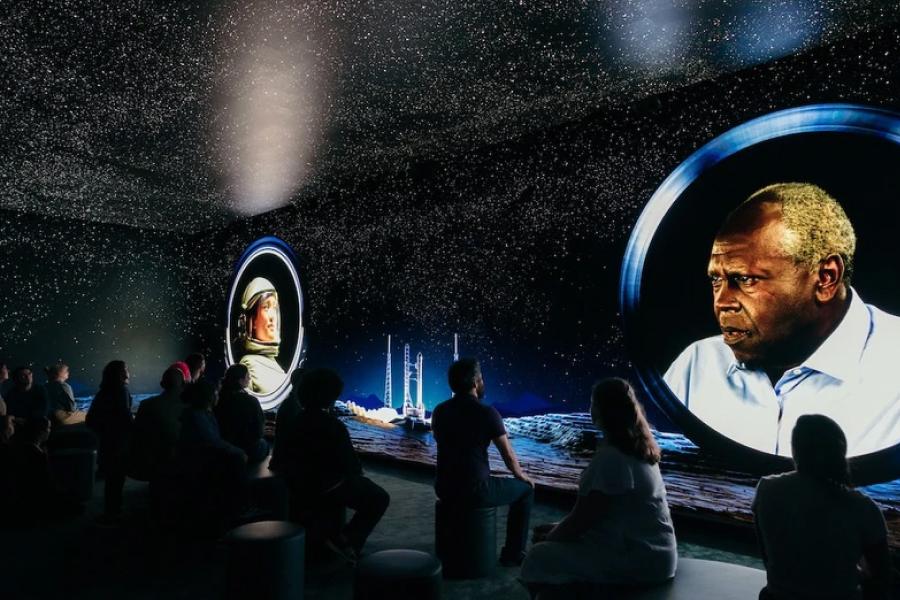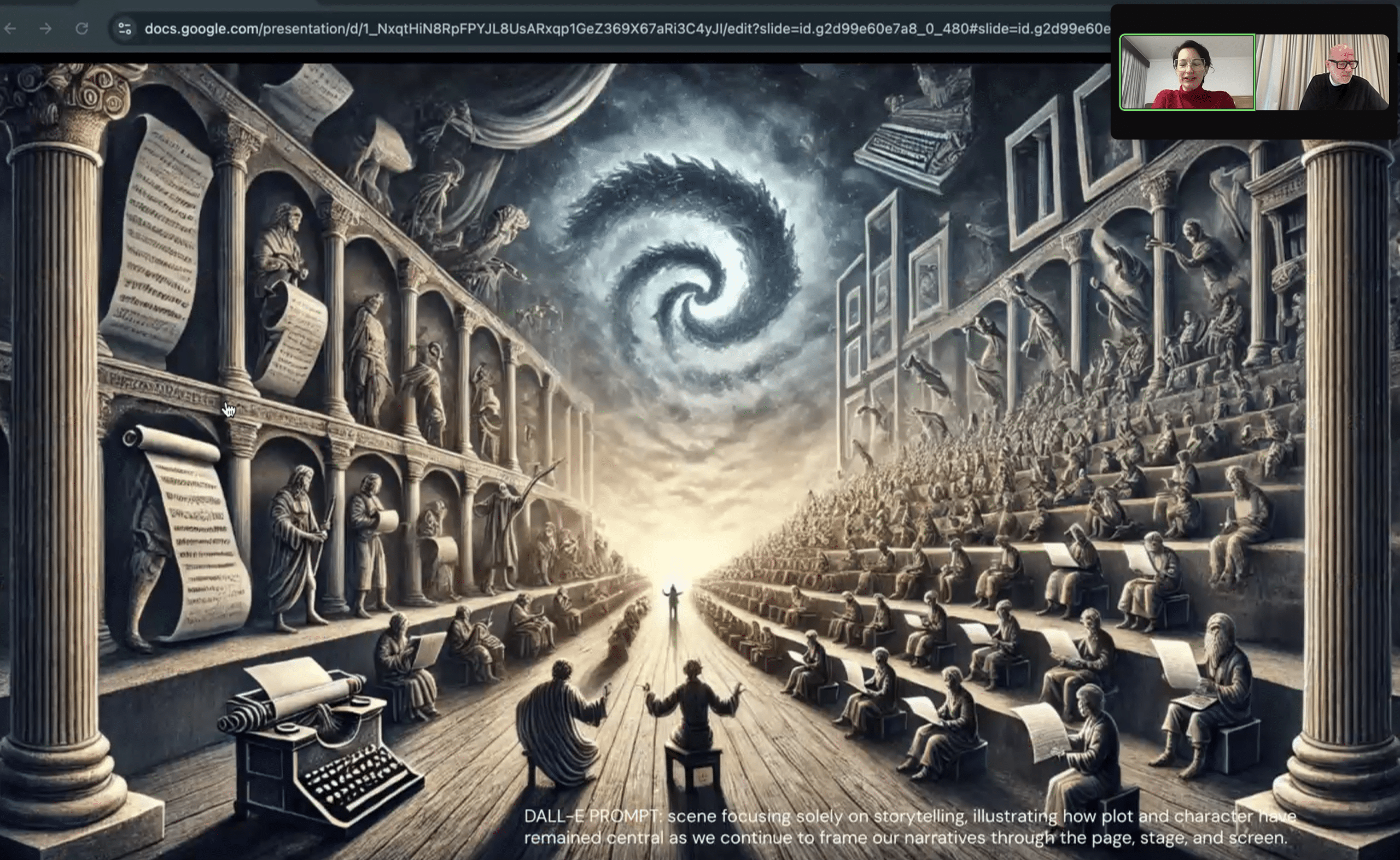What do killer robots, professional wrestlers and Taylor Swift all have in common?
They all engage in the dark arts of deception, lies and experience design. This is a universe of alternative realities, suspension of disbelief, and co-authoring in the context of staged experiences – and there’s much we can learn within it to inspire wonder, foster community, and breed superfans in our experiences.
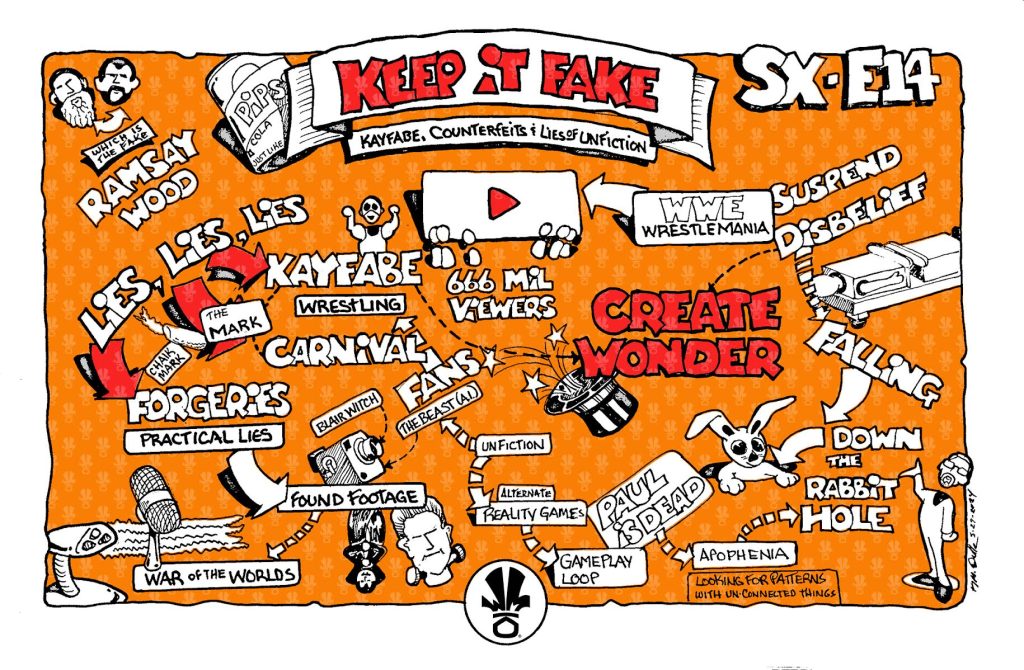
Experience designer, game maker, Unfiction author and dreamer of dreams Ramsay Wood is your guide through the two design philosophies this counterfeit world is built on: Kayfabe and Unfiction. Wood worked at the immersive theatre department at Boomtown Festival, introducing Alternate Reality Gaming and Unfiction elements to its narrative design, and also produced the transmedia game Pictures of Gwen.
In this fascinating, mind-popping introduction to lies and deception as an experience design tool, you’ll take a trip through how they’re used in professional wrestling, crooked carnivals, stage magic, Alternate Reality Games, “found” media, Mockumentaries, and transmedia make-believe.
You’ll also discover how to craft your own counterfeit worlds, as well as your responsibility to your audience when dabbling in these dark arts.
Kayfabe: Self-Deception, Forgeries & Practical Lies
“Think like a forger.” – Mike Monello, Co-Founder, Campfire / Blair Witch Project
When we talk about forgeries, we’re not talking about simply a copy, clone, or case of mistaken identity. Forgeries aren’t artificial, either – a sweetener isn’t a forgery, for example.
Instead, forgeries are “practical lies”, in the manner of a practical joke. They are an imitation, counterfeit, fake. Common forgeries might be an artwork, passport, or bank note.
And in the world of “fake” live entertainment, professional wrestling is the heavyweight.
“Pro wrestling is one of the most misunderstood and underappreciated form of performance art.” – Ramsay Wood
We might think of it as sport, but wrestling is actually one of the most consumed forms of live theatre. WWE’s Wrestlemania 40 – the Superbowl of the wrestling world – drew 660m views across all video platforms. Forbes estimated it generated $1.25bn economic impact for the host city. And the brand’s weekly TV show, Raw, will move to Netflix next year as part of a 10-year rights deal worth over $5bn, as Netflix understands it has a huge, passionate, and multigenerational fanbase.
But Don’t You Know Pro Wrestling Is Fake?
This is the first thing people usually say when you talk about professional wrestling. But the rabbit hole runs much deeper than that…
Wrestling is actually a form of Kayfabe: “a tacit agreement between professional wrestlers and their fans to pretend that overtly staged events, stories and characters are genuine”. According to WWE wrestler Nick Rogers:
“The unspoken contract between wrestlers and spectators: we’ll present you something clearly fake underneath the insistence that it’s real, and you will experience genuine emotion. Neither party acknowledges the bargain, or else the illusion is ruined.” Nick Rogers
If your audience truly believes that the thing they’re watching is real, it isn’t Kayfabe. Here, there are no “gotcha” moments – we know it’s not real, but we love it because it’s what we signed up for. This is what makes it different from a phishing or romance scam.
It’s also why you need guardrails and safety rules there from the start. If your subject matter is fantastical – like a giant lizard destroying the city, or a spaceship set over 100 years in the future – it gives you more headroom to be a bit loose.
But if this isn’t clear, it’s vital to have some indications in place. In wrestling, for example, performers do an X sign with their arms to show they’re really injured or that a fan has jumped the guardrail, but in a way that doesn’t betray the spirit of the show.
Strongmen & Secret Societies
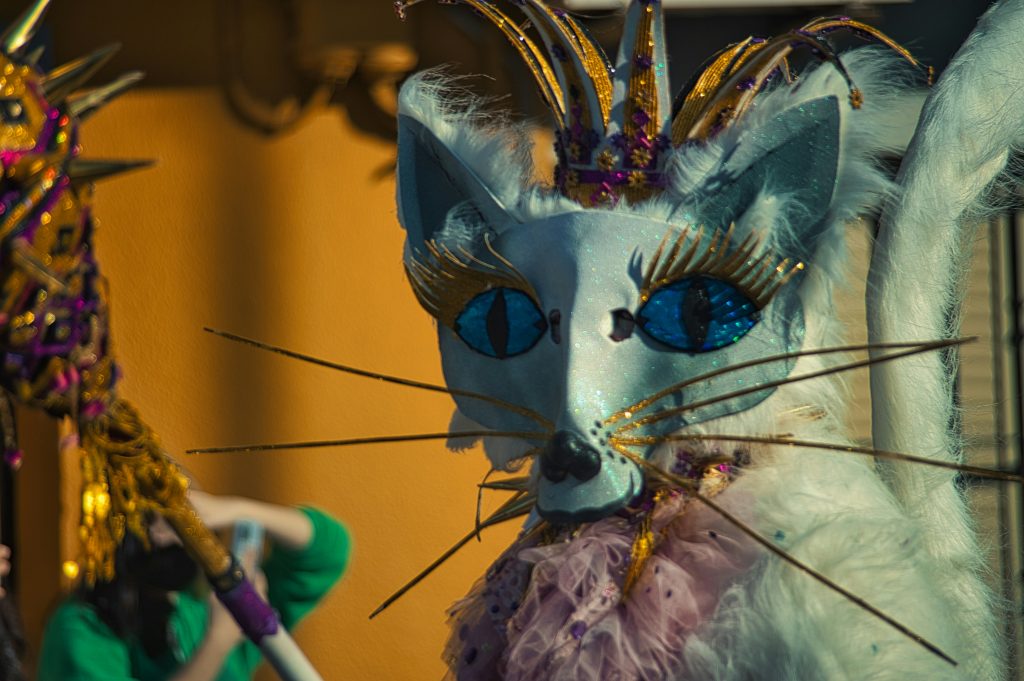
The culture of professional wrestling and Kayfabe emerged from the travelling carnival circuit of the late 19th and early 20th centuries. We associate these with spectacle and show, but also crooked games and gambling – which is where the idea of the mark, punter or billy came from.
This refers to a gambler, or someone who likes to take chances. A chalk “mark” would be made on the back of a patron to indicate to the rest of the carnival that this person was gambling excessively, drunk, and so on. The term “mark” is still used today to refer to the audience.
Among the usual attractions of the carnival – acrobats, aerialists, clowns, jugglers, exotic animal shows – in the 19th century the strongman became a popular stalwart of the entertainment on offer. The strongman involved various feats of strength – some legitimate, some less so – often challenging members of the audience to take him on.
Legitimate, trained tough guys were known as “shooters”, but around the 1910s-20s we saw a transition from the shooter to the “worker”, and from legitimate contest to cooperative, staged performance operating under the rules of Kayfabe.
Kayfabe allows for traditional story shapes to be told or directed. The story structure for professional wrestling looks much like the Hero’s Journey – in the “shine” our hero demonstrates his skill, before being cut off by the villain in the “heat”, followed by an impossible overcoming or “comeback”, leading to the “finish” or climax.
Kayfabe permits the impossible, allows us to access emotion and creates memories, all of which are an integral part of experience design. And it creates a secret society of those who are in on the joke, which is also an important aspect of fandom. Under Kayfabe, both marks (audience) and workers (performers) agree to treat work (staged performance) as shoot (legitimate).
Epistolary Novels, Mockumentaries & Found Footage
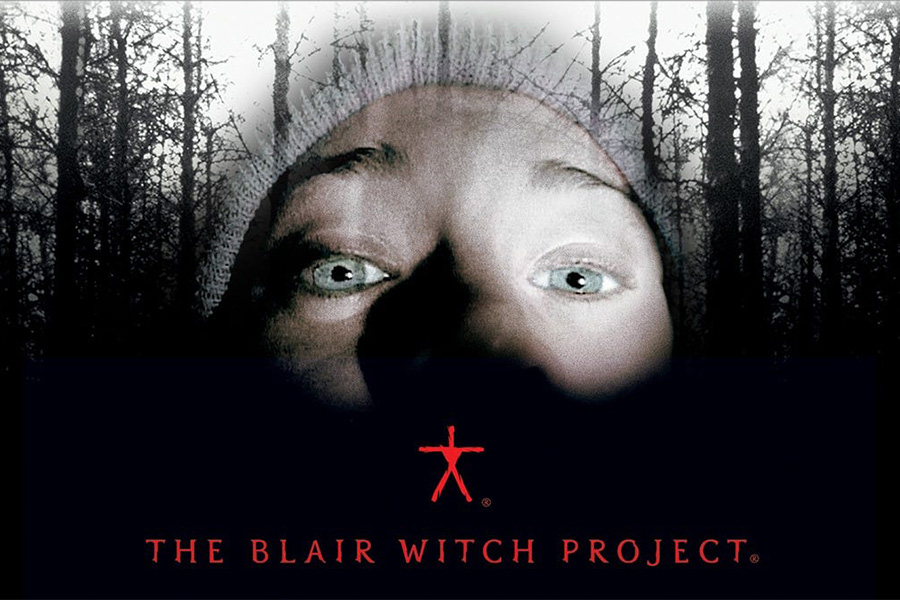
“History is a set of lies agreed upon” – Napoleon Bonaparte
This tradition of media presenting itself as another type of theatre has a history going back several hundreds of years. Think of early epistolary novels masquerading as a collection of “letters”, like Frankenstein and Dracula.
As new forms of media arrive, they facilitate new stories. In HG Wells’ War of the Worlds radio broadcast, it was presented as a legitimate news broadcast of a Martian invasion that struck fear into the hearts of those who took it for real. This form pioneered the pseudo-documentary on TV, such as Panorama’s “spaghetti harvest” or the “live” Halloween broadcast of Ghostwatch.
While there’s a narrative that many people were fooled by these experiments, there’s also a decent amount of evidence that this reaction was overblown by the media and that audiences can tell fact from fiction and have a lot of fun playing along. Being a fan means having fun with the fourth wall and not knowing where the reality lies, and not being troubled by it. The same can be said about reality TV – speculation about what’s real and what isn’t fuels the fandom.
Later mockumentaries or comedy vérités like The Office, Curb Your Enthusiasm, People Just Do Nothing, Spinal Tap and Borat used the same conceit to explore comedy and satire rather than fantasy or horror.
We also saw an evolution towards found footage, which arguably reached its peak in 1999’s seminal, found-footage horror film, The Blair Witch Project. This was presented as authentic through transmedia “proofs” in print media, TV, websites, myth making via specialist forums, fake news reports and staged interviews with law enforcement.
“I haven’t used Kayfabe to describe Blair Witch, but that’s what it was. There was no way to communicate it in our structure to people, so it flipped to a lot of people thinking it was real – it was called a hoax when it entered the mass consciousness, rather than a story. Similar to War of the Worlds, some people missed the Kayfabe part. Looking back, that’s a design flaw that we had.” – Mike Monello
To hear more from Monello on how he used transmedia storytelling to build a new kind of cinema experience, check out his Campfire How To Design Experiences For Fans & Superfans.
This Is Not A Game: Unfiction & Alternate Reality Games
The extensive use of transmedia was used in arguably the first Alternate Reality Game (ARG), the promotion for the film AI called The Beast, an investigation of the murder of Evan Chan by his companion bot in the year 2142.
Unlike most tie-ins where the game was overtly announced, The Beast utilised the “rabbit hole”: a trailhead or entry point. Trailers and posters crediting a Dr Jeanine Salla as Sentient Machine Therapist contained a hidden phone number and coded message: “Evan Chan was murdered. Jeanine is the key”.
These cumulative proofs in print media, graffiti, telephone messages, live actors and meetups, extensive websites and so on created an alternate reality: a tangible, counterfeit world that can be interacted with just like ours. Once the game began and people started talking about it, trailer was released with the message “This Is Not A Game”. The Beast won a Peabody Award in 2022, years after it first appeared.
This is not a game, this is not fiction – this is Unfiction. All ARG are Unfiction, but Unfiction also includes non-interactive work. ARGS are interactive transmedia, most commonly large-scale and multiplayer, with an emphasis on community and collaborative play. They are characterised by medium breaking and the “This Is Not A Game” ethos.
But ultimately it is a game, and games have a core loop – in Snakes & Ladders, for example, you roll the dice to move that number of squares. In Sonic, you collect rings and avoid obstacles. And in ARG, a dedicated fanbase consumes the media looking for hidden clues.
Down The Rabbit Hole In Pop Culture: The Beatles To Taylor Swift
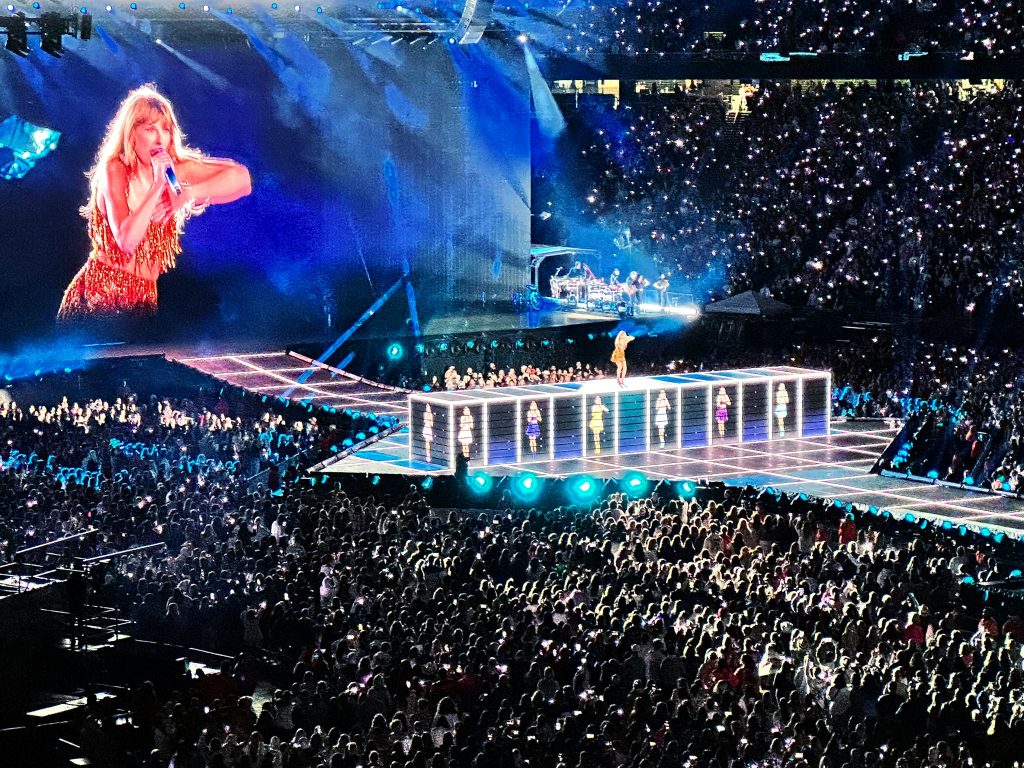
There’s a fan theory that Paul McCartney was killed in a car crash, and The Beatles replaced him with a lookalike in association with MI5 – but left hidden clues within their music and artwork to tell fans he’s dead. This led to huge speculation and lots of media coverage.
Similarly, in The 7 Day Theory many people speculate that in the album of the same name by 2Pac, it contains secret messages alluding to the fact he’s about to fake his death.
Most cases like these can be put down to apophenia: the tendency to perceive meaningful connections where there aren’t any. If you put on Pink Floyd’s The Dark Side of the Moon and the Wizard of Oz at the same time, for example, there’s a belief that they sync up perfectly. They don’t, of course, but our brains want them to.
But there are some people who may be deliberately hiding messages in their work. Take Taylor Swift, for example: the voice of a generation with the highest grossing tour of all time and a net worth of $1.14bn. Swift has spoken publicly about incorporating clues in her work since the age of 14.
“Look, I think that it is perfectly reasonable for people to be normal music fans and have a normal relationship to music… but if you wanna go down a rabbit hole with us… come along, the water’s great, jump in – we’re all mad here”. – Taylor Swift
For the people who understand, the above is a message about Alice in Wonderland, immersion, and uncovering something beyond the obvious. Examples of Swift playing with Unfiction in her work are numerous and complex to follow for the uninitiated. The “Lover House”, for example, is an iconic motif of a doll’s house that appears throughout her work and can be thought of as a key to unlocking the Taylor Swift story, with each room representing an album or “era”.
This is continued in the Bejeweled music video: the colours in the elevator detail her work. In the Karma video, her blue nail refers to the album 1989, which was due to be released in August and correlates to 8. A black nail represents the album Reputation, which we can expect to be released in February. During Swift’s Grammy Awards appearance, her website crashes, showing a 321 error and “hneriergrd”, an anagram of “red herring” – instead she announces The Tortured Poets Department, then reveals a secret mirror album themed around the colour black.
While this might be hard to decode for those outside the fandom, it engages not only fans but also press speculation, getting huge results. At a typical live show, ancillary spend will be around $300 on hotels, food and so on for every $100 spent on a ticket. At Swift’s Eras tour, this ancillary spend was more like $1,200 – four times the average.
The WXO Take-Out
Wood concludes that when we engage in Kayfabe and Unfiction, we can:
- Inspire wonder and a sense of imagination for guests.
- Appeal to human curiosity and our desire for answers.
- Foster community via collaboration and common goals.
- Create a powerful, viral onboarding tool.
- Realise that superstars breed superfans.
While we need to have intentionality about what we’re building, who we’re reaching, and how they might bring that interaction into the real world, when handled responsibly we can use willing deception and lies to create stickier, more memorable and more meaningful experiences. It’s like the Magic Circle, but for experiences: an invitation to step into another world where different rules apply and willingly put aside the everyday.
So next time you’re designing an experience, ask yourself:
- What tacit agreement are you making with fans? How are you asking them to suspend disbelief?
- How can you make people feel like they’re co-creating the story with you, while maintaining structure?
- What guardrails do you need to put in place to tell an “ethical / acceptable lie”?
Want to come to live Campfires and join fellow expert experience creators from 39+ different countries as we lead the Experience Revolution forward? Apply to join the WXO today.




